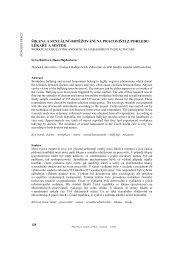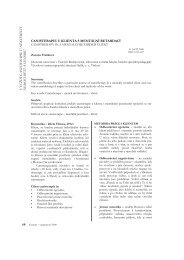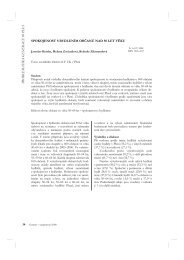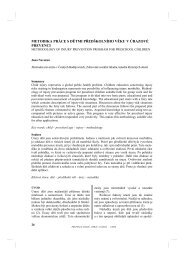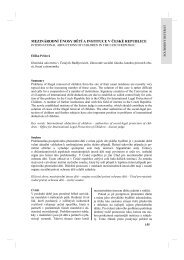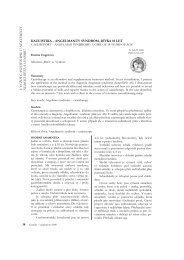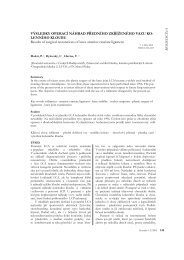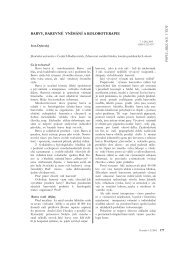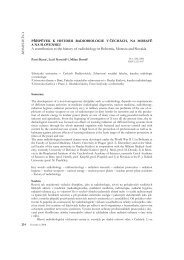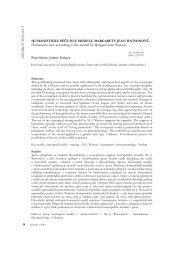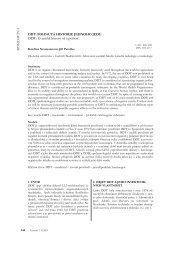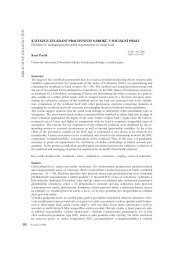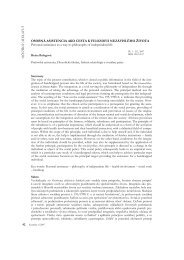REVIEW
REVIEW
REVIEW
Create successful ePaper yourself
Turn your PDF publications into a flip-book with our unique Google optimized e-Paper software.
Examination methods<br />
In addition to clinical condition assessment,<br />
many laboratory and imaging methods are<br />
used for precise diagnostics to determine the<br />
level and extent of the patient’s disease with<br />
the diabetic foot syndrome.<br />
Basic medical history data, we try to find<br />
out, is the diabetes type and its duration.<br />
Diabetes duration isn‘t decisive for the<br />
extremity amputation, as in 15–19%, diabetes<br />
mellitus is diagnosed only in a situation<br />
leading to an extremity loss (Piťhová 2008).<br />
Furthermore, we determine the presence<br />
of the specific chronic complications<br />
(neuropathy, retinopathy), presence of<br />
cardial and vascular disease, possibly the<br />
undergone interventions. Further important<br />
medical history data are: smoking, lipid<br />
metabolism disorder, other serious general<br />
illnesses (liver, kidney illnesses, rheumatoid<br />
arthritis, psoriasis, even depressions). Social<br />
situation of the patient is of considerable<br />
importance, too – loneliness, low social level,<br />
homelessness, previous non-compliance.<br />
Neuropathic problems are the subjectively<br />
serious ones (fornication, prickling,<br />
feet sweating disorders), resting pain or<br />
claudication pain, gait problems.<br />
Clinical examinations: Via palpation, the<br />
physician determines the pulsation on the<br />
arteries, via auscultation, the presence of<br />
murmurs over big arteries. Then, the anklearm<br />
index is determined. Using the Doppler<br />
method, the blood pressure is measured on<br />
both arms in horizontal position, then on<br />
dorsal pedis artery and posterior tibial artery.<br />
Peripheral systolic blood pressure > 100 mm<br />
Hg indicates good blood perfusion of the<br />
extremities, values in the range of 50–100<br />
mm Hg indicate a medium perfusion disorder.<br />
Chronic critical extremity ischemia is a<br />
disorder significant due to hematodynamics<br />
changes that developed gradually. It is defined<br />
by resting pain lasting for more than 2 weeks<br />
or ulceration or gangrene presence. Systolic<br />
ankle blood pressure is < than 50 mm Hg,<br />
systolic pressure on the thumb < than 30<br />
mm Hg and the TcpO 2 < 10 mm Hg doesn‘t<br />
increase after oxygen inhalation.<br />
If the absolute value of the ankle blood<br />
pressure is higher than 220 mm Hg or the<br />
ankle-arm index is > 1.25, medicalcinosis is<br />
present.<br />
135<br />
Diabetic food syndrome<br />
Laboratory examination: used in the<br />
diabetic patients with a diabetic foot can be<br />
divided into 3 groups:<br />
1) Examinations monitoring the diabetes<br />
mellitus<br />
Glycemia is the basic monitored value,<br />
the target fasting glycemia is 4–6 mmol/l,<br />
postprandial glycemia 5–7.5 mmol/l.<br />
Glycated hemoglobin is a basic<br />
examination monitoring the long-term<br />
compensation of diabetes. The percent<br />
of the glycated hemoglobin reflects the<br />
glycemia for the last 2–3 months (target<br />
values are less than 4.5%).<br />
Further laboratory examinations are<br />
a detailed lipidogram, mineralogram,<br />
creatinine, urea, uric acid, hepatic tests<br />
(Haluzík 2009).<br />
2) Examinations for inflammation monitoration<br />
The default objectification method is<br />
measuring of the body temperature, then<br />
blood count (leukocytosis, typical shift in<br />
the white cells differential), sedimentation<br />
– FW, C-reactive protein (a component of<br />
the non-specific humoral immunity) and<br />
procalcitonin (Kolář 2008).<br />
In diabetic foot syndrome, microbiology<br />
examination is very important. It is<br />
necessary to collect the material from<br />
the festering focuses for cultivation and<br />
sensitivity assessment repeatedly and<br />
carefully to avoid contamination.<br />
3) Laboratory examinations performed in<br />
the pre-operative examination (Skalická<br />
2007).<br />
Imaging methods<br />
An X-ray image of the foot in two projections to<br />
show osteoporosis, subchondral pseudocysts,<br />
spontaneous fractures or soft tissue edema.<br />
Complicating osteomyelitis leads to osteolyses<br />
and deformations in the bone structure and to<br />
subluxations (Lacman et al. 2005).<br />
Ultrasonography examination allows both<br />
function (blood pressure measurement) and<br />
morphology examination of the arterial system.<br />
Using a two-dimensional ultrasonography<br />
imaging of the anatomy structures, it is<br />
possible to assess the arterial lumen and to<br />
find the stenoses and obstructions. Doppler<br />
techniques provide hemodynamic data about



